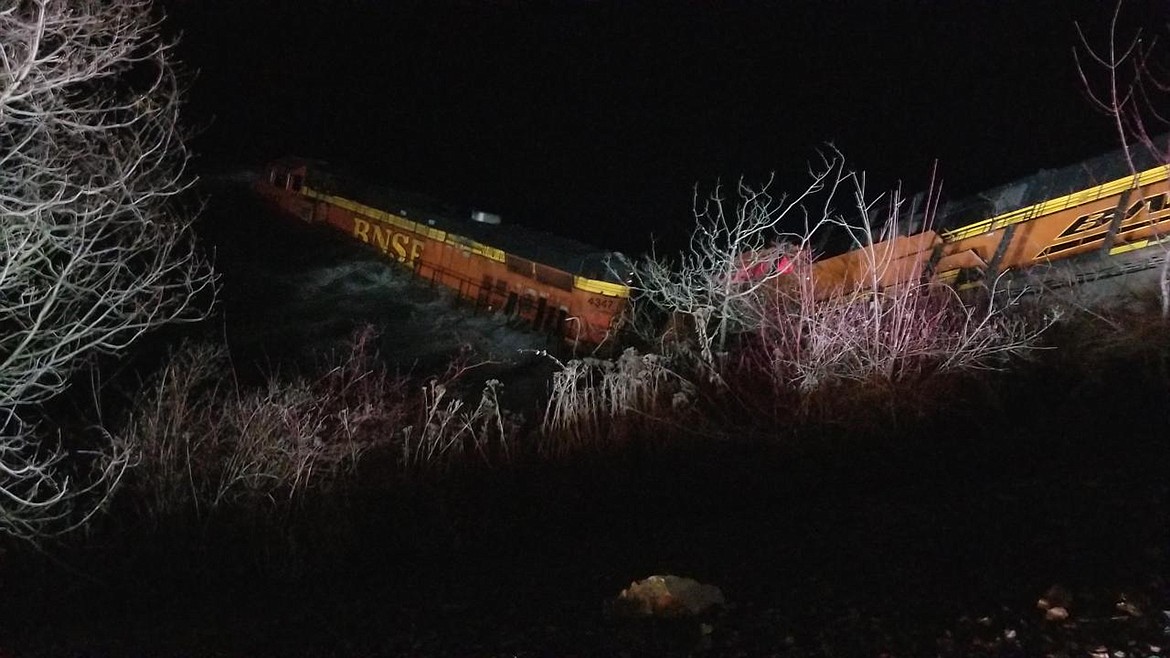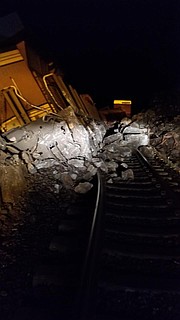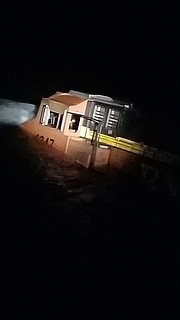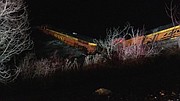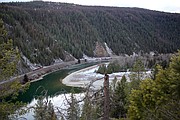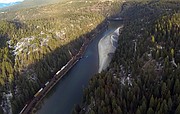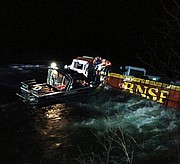Rockslide likely caused BNSF derailment
Hagadone News Network | January 3, 2020 3:00 AM
BONNERS FERRY — A rockslide likely caused the derailment of a mile-long BNSF Railway train Wednesday night, sending an engine with its two-person crew plunging into the Kootenai River.
The crew — a conductor and an engineer from the Spokane/North Idaho area — were not injured, said Gus Melonas, director of public affairs for BNSF Railway for the region.
“The crew is fine, they’re good,” he added Thursday.
Various personnel responded within minutes of the derailment, which was reported at 8:45 p.m.
With the crew safely ashore, efforts turned to creating a plan to get the locomotive out of the water, Melonas said, as well as a second locomotive up from the riverbank. It’s likely a platform will be built to stage equipment, including cranes with cables to pull the locomotives up and re-rail them, he said. Equipment was en route Thursday by railcar from Libby, Mont., and from Pasco, Wash.
“We’re on site and investigating and we have geo-techs looking at the slope,” he said. “We have experts on site now with positioning equipment to re-rail and to begin the cleanup process.”
Melonas said the six derailed cars were empty and plans are already underway to replace the damaged track. However, because geo-technicians are still on site assessing the stability of the slope, it’s unknown when the line will be reopened.
BNSF crews were removing fuel from the locomotive on the bank. Booms have been deployed downstream to contain any diesel that leaked from the lead locomotive. Melonas said it’s unknown how much diesel entered the river but the lead locomotive did not have a full tank and diesel from the second and third locomotives did not spill anything.
While the six cars that derailed were empty, Melonas said it’s unclear what other cargo was aboard the mile-long, mixed-merchandise train that originated in Minneapolis and was headed for Pasco. While early reports indicated some of the cars near the back of the train may contain hazmat, Melonas said he didn’t have any information on the other cargo or the positioning of those cars on the train.
Boundary County Sheriff Dave Kramer said Thursday that pre-planning and training helped ensure a successful rescue and response to the derailment.
“For an incident like this, we had tremendous support from all the first responders and everyone involved,” Kramer said. “We really appreciate Two Bear Air being there. As it turns out, we were able to rescue the employees with the Sheriff’s boat, but Two Bear was there as backup. Everything came together well.”
BNSF has booms staged in a building behind the Sheriff’s Office, with South Boundary Fire, and at Twin Rivers. That equipment is available for use in the county for any incident, train-related or not.
“The preplanning and having the materials readily available really helped,” Kramer said.
Kramer praised Marine 1, the Boundary County Sheriff’s boat crew and dispatchers, which brought additional staff on board to help during the emergency. Making the response even more notable is the remoteness and difficult terrain.
“It is a challenge going up that part of the river, even in the daylight, with the low waters and sandbars that need to be negotiated,” he said. “Despite the conditions, they did a great job. This shows our community how many first responders turned out from just about every agency to bring this to a successful resolution.”
Rescue crews, including a BNSF employee who responded to the scene, found the conductor and the engineer on the engine. A first respondeer said the BNSF employee smashed one of the windows on the train to get the trapped employees out and on top of the train. A medic and a firefighter showed up in a high rail truck with life jackets and helmets for the train crew, said a rescuer who asked that his name not be used.
About the same time, the BCSO boat arrived on scene, tied up to the lead engine and were able to rescue the stranded employees.
South Boundary Fire Chief Tony Rohrwasser praised the rescue operation and the coordinated response.
“It was well put together,” he said. “They did a great job with both command and operation. All of the different agencies worked well together.“
As various crews responded, North Bench Fire Chief Gus Jackson established a command center in the Riverside area, which then was transitioned into a unified command between the multiple responding agencies.
“It was a very in-depth and complex scenario with multiple resources,” Jackson said.
While Two Bear Air Rescue out of Flathead County, Mont., responded to the scene, they ended up not being needed to pull the crew from the partially submerged locomotive.
“They flew through very bad weather, which was awesome of them,” Jackson said. “I think it was fantastic despite all of the challenges and risks involved with it being on the water and at night.”
Because of the coordinated response and training, Boundary County officials said the result was as positive an outcome as possible given the circumstances.
“We were able to safely prevent loss of life, rescue the crew members, and prevent further environmental damage,” Jackson said.




